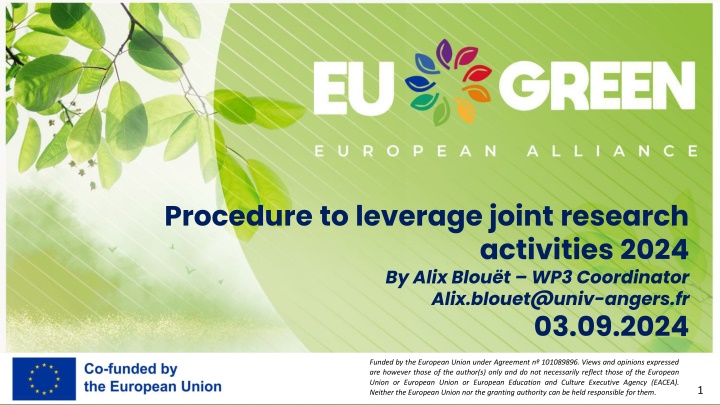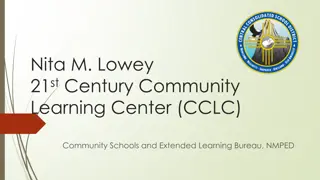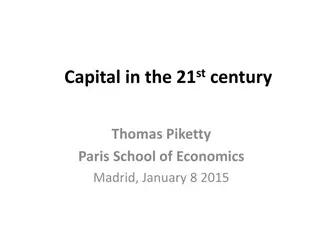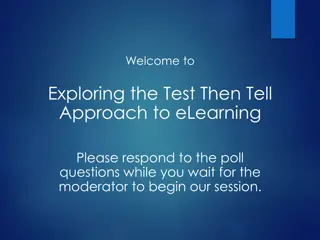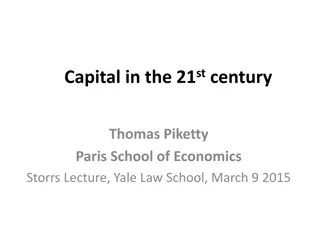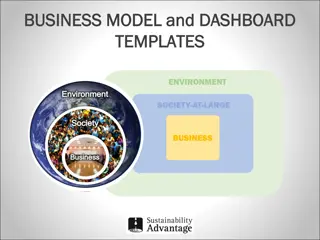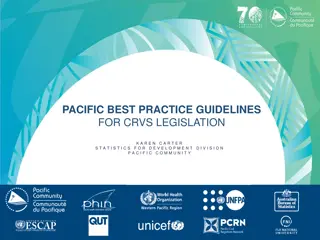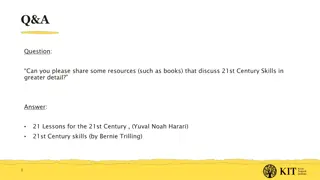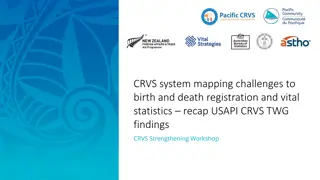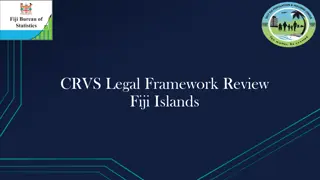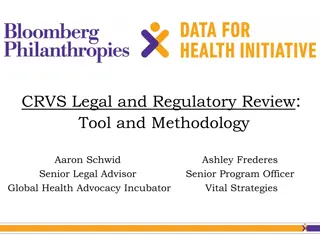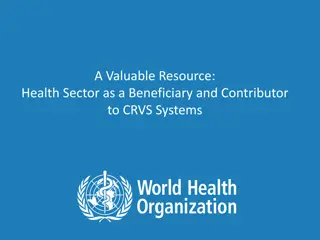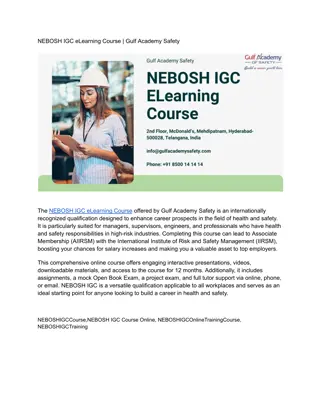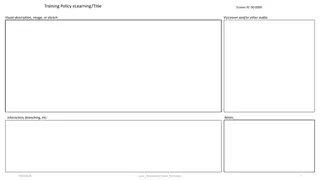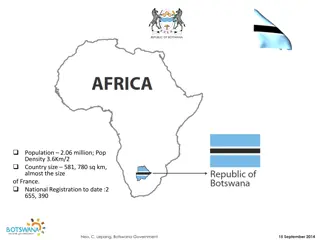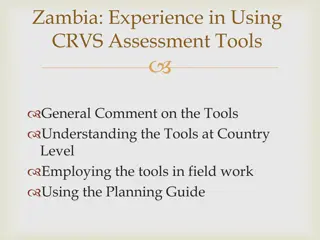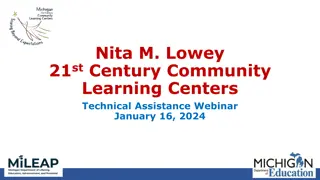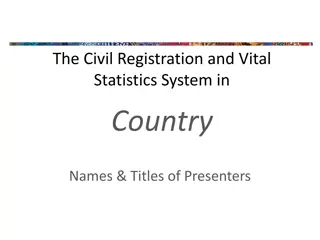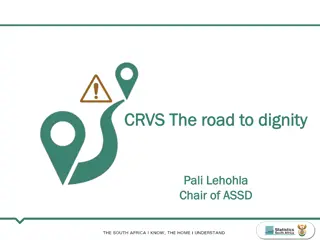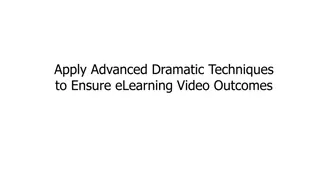21st Century CRVS eLearning Course - Practical Tools and Approaches
This eLearning course on Civil Registration, Vital Statistics, and Identity Management Systems offers modules covering topics such as Institutional Arrangements, Birth Registration, Death Registration, Marriage and Divorce Registration, and more. Each module includes lessons with key messages, country examples, self-tests, and interactive exercises to enhance learning. Designed for policy makers, university students, and professionals in various fields, this course aims to provide practical tools for building and maintaining CRVS systems tailored to local contexts.
Download Presentation

Please find below an Image/Link to download the presentation.
The content on the website is provided AS IS for your information and personal use only. It may not be sold, licensed, or shared on other websites without obtaining consent from the author.If you encounter any issues during the download, it is possible that the publisher has removed the file from their server.
You are allowed to download the files provided on this website for personal or commercial use, subject to the condition that they are used lawfully. All files are the property of their respective owners.
The content on the website is provided AS IS for your information and personal use only. It may not be sold, licensed, or shared on other websites without obtaining consent from the author.
E N D
Presentation Transcript
Procedure to leverage joint research activities 2024 By Alix Blou t WP3 Coordinator Alix.blouet@univ-angers.fr 03.09.2024 Funded by the European Union under Agreement n 101089896. Views and opinions expressed are however those of the author(s) only and do not necessarily reflect those of the European Union or European Union or European Education and Culture Executive Agency (EACEA). Neither the European Union nor the granting authority can be held responsible for them. 1
Outline 1. 2. 3. Basics Calendar Let s get into details: Pillar 1 & 3 Incentive for collaborative research projects & scientific conferences Let s get into details: Pillar 2 Researcher mobility program Questions 4. 5. The necessarydocuments The bill of specification The application forms The financial form All available here : https://wp3eugreen.univ-angers.fr/en/index.html 2
1. Basics EU GREEN has established a yearly joint procedure for proposals to stimulate research collaboration among our 9 universities. Researchers from EU GREEN partner universities can submit proposals for seed funding. This procedure, implemented by the Work Package Research (WP3), is intended to leverage cooperation between researchers and create new or consolidate existing scientific relationships. Its vision is to build robust scientific communities among the EU GREEN universities. There are 3 pillars for the 2024 call: 1. Incentive for collaborative research activities, up to 20,000 2. Researcher mobility program, up to 2000 per mobility per person 3. EU GREEN Scientific conferences, up to 10,000 3
2. Calendar (commonfor the 3 pillars) ndof September 2024 Application open 1 2 3rd of September 2024 from 10 am to 11 am CET Click here to join 10 CET Click here to join 2 stonline information session ndonline information session thof October 2024 from 10 am to 11 am 2 ndof November 2024, 10 PM CET Application close 4
Clusters will provide an opinion on how the projects submitted fit into the cluster s activities and scope to show the relevance and the work done together by the applicants and the cluster. WP3 team will send the relevant applications to the clusters. Deadline to send the cluster opinions to eugreenwp3@univ-angers.fr Joint Research commission Seed funding selection Week 45/46 It s up to the clusters to get organised to set up the meeting and the redaction of the opinion. November 15 PM CET 05 from 2 pm to 4 pm CET Before the 30 December 2024 1 31st of December 2026 31 th2024, 10 thof December 2024 thof Notification to applicants stof January 2025 Latest date for projects to start Latest date for project to end Final report due stof January 2027 5
Clusters are not closed boxes. Your project can fit ! CLUSTER CONTACT Mariana Muresan (she/her) mmuresan@uoradea.ro Tomina Saveanu (she/her) tomina.saveanu@gmail.com Elena Maestri (she/her) elena.maestri@unipr.it Federico Righi (he/him) federico.righi@unipr.it Cluster 1 Emerging paradigms for health and wellbeing Cluster 2 Agriculture, food and environmental sustainability Cluster 3 Ulrich Krause (he/him ulrich.krause@ovgu.de Engineering and technology for sustainable development Cluster 4 Junwei Yu (he/him) junwei.yu@univ-angers.fr Sustainable tourism for cultural and natural heritage Cluster 5 Assun ao Folque (she/her) mafm@uevora.pt Education sciences for sustainable development Cluster 6 Challenges in ecosystem biodiversity and function, A macroregional evaluation Victor Rolo (he/him) rolo@unex.es 6
Tip Contact the relevant cluster leader as soon as possible, even if your idea is not fully formed. Why? an opinion is asked from the cluster and will be taken into account for the evaluation : Clusters will provide an opinion on how the projects submitted fit into the cluster s activities and scope to show the relevance and the work done together by the applicants and the cluster. WP3 team will send the relevant applications to the clusters. It allows the JRC to have an overview of what the project will bring to the cluster. 7
3. Letsget intodetails: Pillar 1 & 3 Incentive for collaborative research projects & scientific conferences Objective : structure collaboration between the EU GREEN partners in research 8
This incentive wont fund for projects in their own right; the laureates will be activities within a WP3 task. The relevant fact is the objective of the activity that is being carried out, which should not be research per se up to 20,000 Incentive for collaborative research project This action should support concrete exploratory collaborative activities by research teams with single or multiple disciplines that put forward the complementarity of competences and approaches to build other bigger projects to be submitted to external research funds. Those activities could facilitate travel and networking, information sharing, gaining access to data, preparing a larger publication on research outcomes, lead to the application to European projects (i.e. financing consortium meeting to prepare European application) or to the creation of new sub-group etc. 9
up to 10,000 for organisation Scientific conferences This action should support the organisation of scientific conferences aligned with EU GREEN sustainability main theme and/or the cluster's scope. These funds can be used to either cover operating costs or support the travel of lecturers and/or participants. The conference should be organised in one of the 9 EU GREEN universities and should forecast a detailed communication plan. The budget may include the travel fees of the EU GREEN researchers to come to the conference. As a result, indexed conference proceedings will be asked. 12
Check Check that thatyour your project project Has these mandatory elements : 3 EU GREEN partners at least Number of EU GREEN clusters that are covered by the project Will be completed within 2 years Maximum budget respected Answers sustainability challenges No double funding CV PI Carbon footprint assessment Use Lab1point5 to assess mobilities 15
Evaluation criteria Common criteria / 25 Relevance of the project for EU GREEN mission and vision and convincing argumentation of the EU GREEN added value of the intended collaboration /10 Relation to cluster topics and number of clusters involved in the project /10 Relation to other WPs /5 16
Criteria specific action 1 & 3 Scientific excellence Participation of Early Career Researchers, graded as follows : /55 /15 - Participation of 3 ECR at least: 5/10 - Participation of more than 3 ECR: from 5 to 7/10 - Participation of more than 3 ECR + role as PI or local coordinator: from 7 to 10/10 /10 Leverage potential (e.g. funding applications to international competitive calls for action 2.1) or sustainability of the collaboration (for action 2.3) /10 Gender balance and gender dimension. A 50/50 repartition will lead to a 10/10 mark. Inequality in both ways will decrease the mark proportionally. Total per project /10 /80 17
Genderbalance Gender repartition in relation to the total number of participants 50/50 Grade 10/10 7/10 60/40 70/30 80/20 90/10 5/10 3/10 1/10 Example: 30 members in the project, 17 women, 13 men = 7/10 22 participants in the project, 5 men, 17 women = 3/10 18
In case of a tie, priorities will be given to project with: (a) early career researchers (b) The highest number of participating partners Early career researchers are : master students, PhD students, those who finished their doctoral thesis less than 8 years ago. 19
Some questions to ask yourself along the way : Is the project aligned with the EU GREEN scope? (think clusters, SDGs, other Work Packages) Have I been careful in designing an application that is not research oriented but which helps structure collaboration in research? Is my project realistic & feasible before December 2026 ? Have I clearly explained the role of each participant ? Have I clearly explained the added value of the project and of the collaboration? Have I clearly identified a European call to apply to ? Have I payed attention to gender balance, have I included young researchers? 21
4. Letsget intodetails: Pillar 2 Researcher mobility program Objective : structure bilateral collaboration between the EU GREEN partners in research 22
2,000 per person (per person, per mobility) Goal of the action 2.2 Researcher mobility program Launch or reinforce research cooperation between EU GREEN institutions on an individual (researchers), intermediate (teams/medium scale projects) or institutional level (research centres/large scale projects, PHD schools etc.) Max per mobility will be granted to cover: travel costs accommodation Food Internal rules of each university still apply 23
Potentialtopics for a mobility Find an expertise that doesn t exist in your university Share knowledge Identify synergies Identify potential calls to apply to Plan the cosupervision of a student Visit research facilities Plan the organization of collaborative events & activities 24
Evaluation criteria Common criteria Relevance of the project for EU GREEN mission and vision and convincing argumentation of the EU GREEN added value of the intended collaboration /25 /10 Relation to cluster topics and number of clusters involved in the project /10 Relation to other WPs /5 Specific criteria for action 2 /15 A detailed programme of the activities to be developed during the visit. /5 The expected outcomes of the mobility visit and next collaboration steps planned after the visit (i.e. visits regarding application to competitive funding) /6 Participation of early career researchers (PhD and Postdoc) /4 Total /40 25
Information box Find all information here (scroll down for the Q&A) Subscribe to the monthly newsletter Curious about the 2023 call? check the laureates here Contact : eugreenwp3@univ-angers.fr Still have questions? The next information session is on October 10th at 10 am CET. Link to join 27
Thank Thankyou you! ! Funded by the European Union under Agreement n :101089896. Views and opinions expressed are however those of the author(s) only and do not necessarily reflect those of the European Union or European Union or European Education and Culture Executive Agency (EACEA). Neither the European Union nor the granting authority can be held responsible for them. 28
